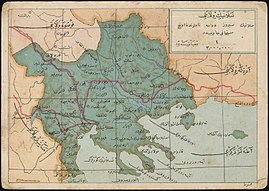Salonica Vilayet
This article needs additional citations for verification. (October 2010) |
| ولايت سلانيك Vilâyet-i Selânik | |||||||||||||||
|---|---|---|---|---|---|---|---|---|---|---|---|---|---|---|---|
| Vilayet of the Ottoman Empire | |||||||||||||||
| 1867–1912 | |||||||||||||||
 Flag | |||||||||||||||
 The Salonica Vilayet in 1900 | |||||||||||||||
| Capital | Salonica[1] | ||||||||||||||
| Population | |||||||||||||||
• 1911[2] | 1,347,915 | ||||||||||||||
| History | |||||||||||||||
| 1867 | |||||||||||||||
| 1912 | |||||||||||||||
| |||||||||||||||
| Today part of | |||||||||||||||

The Vilayet of Salonica[3] (Ottoman Turkish: ولايت سلانيك, romanized: Vilâyet-i Selânik) was a first-level administrative division (vilayet) of the Ottoman Empire from 1867[4] to 1912. In the late 19th century it reportedly had an area of 12,950 square miles (33,500 km2).[5]
The vilayet was bounded by the Principality (later Kingdom), of Bulgaria on the north; Eastern Rumelia on the northeast (after the Treaty of Berlin); Edirne Vilayet on the east; the Aegean Sea on the south; Monastir Vilayet and the independent sanjak of Serfije on the west (after 1881); the Kosovo Vilayet on the northwest.
The vilayet consisted of present Central and Eastern parts of Greek Macedonia and Pirin Macedonia in Bulgaria. Present Pirin Macedonia part of it was administrated as kazas of Cuma-yı Bala, Petriç, Nevrekop, Menlik, Ropçoz and Razlık.[citation needed] It was dissolved after Balkan Wars and divided among Kingdom of Greece, Kingdom of Serbia and Tsardom of Bulgaria in 1913.
Administrative divisions[]
Sanjaks of the Vilayet:[6]
- Sanjak of Selanik (Thessaloniki, Kesendire, Karaferye, Vodina, Yenice-i Vardar, Langaza, Kılkış (It was also called Avrathisar), Katrin, Aynaroz, Doyran, Usturumca, Tikveş, Gevgili)
- Sanjak of Siroz (Serez, Zihne, Demirhisar, Razlık, Cuma-yı Bala, Menlik, Nevrekop)
- Sanjak of Drama (Drama, Kavala, Sarışaban, Taşoz (It was later promoted to sanjak), Pravişte, Dövlen)
- Sanjak of Taşoz (It was initially part of Sanjak of Drama, its center was Vulgaro)
Demographics[]
According to the 1881/82-1893 Ottoman census the vilayet had a total population of 1.009.992 people, ethnically consisting as:[7]
- Muslims - 450.456
- Greeks - 282.013
- Bulgarians - 231.606
- Jews - 41.984
- Catholics - 2.654
- Protestants - 329
- Armenians - 48
- Foreign citizens - 1.272

According to the 1906/07 Ottoman census the vilayet had a total population of 921,359 people, ethnically consisting as:[8]
- Muslims - 419.604
- Orthodox Greeks - 263.881
- Orthodox Bulgarians - 155.710
- Jews - 52.395
- Wallachians (Vlachs) - 20.486
- Gypsies - 4.736
- Catholic Greeks - 2.693
- Oriental Armenians - 637
- Protestants - 329
- Catholic Armenians - 58
- Latins - 31
- Syrians - 4
- Foreign citizens - 795
According to an estimate by Aram Andonian in 1908 there was the following ethnic distribution in the vilayet:[9]
- Orthodox Bulgarians - 446,050
- Muslim Turks - 333,440
- Orthodox Greeks - 168,500
- Muslim Bulgarians - 98,590
- Jews - 55,320
- Orthodox Vlachs - 24,970
- Muslim Gypsies - 22,200
- Mixed - 16,320
Governors[]
- Mehmet Akif Pasha (June 1867 - February 1869)
- (February 1869 - September 1871)
- (September 1871 - May 1872)
- Hurshid Pasha (May 1872 - August 1872)
- (1st time) (August 1872 - May 1873)
- Mehmet Akif Pasha (3rd time) (May 1873 - September 1873)
- (October 1873 - February 1874)
- (2nd time) (February 1874 - September 1875)
- (December 1875 - June 1876)
- (June 1876 - April 1877)
- (June 1877 - December 1877)
- (December 1877 - July 1878)
- Halil Rifat Pasha (July 1878 - March 1880)
- (March 1880 - June 1880)
- (August 1880 - January 1882)
- (March 1882 - September 1885)
- (September 1885 - August 1886)
- (August 1886 - August 1891)
- Mustafa Zihni Pasha (October 1891 - November 1895)
- Hasan Fehmi Pasha (1st time) (1895)
- (January 1896 - January 1899)
- (January 1899 - May 1901)
- (May 1901 - May 1902)
- Hasan Fehmi Pasha (2nd time) (May 1902 - September 1904)
- (September 1904 - August 1908)
- (August 1908 - September 1909)
- (September 1909 - January 1912)
- (January 1912 - 8 August 1912)
- (August 1912 - September 1912)
Notes[]
- ^ Geographical Dictionary of the World, p. 1626, at Google Books
- ^ Teaching Modern Southeast European History Archived 2012-03-20 at the Wayback Machine. Alternative Educational Materials, p. 26
- ^ Chisholm, Hugh, ed. (1911). . Encyclopædia Britannica (11th ed.). Cambridge University Press.
- ^ Rumelia at the Encyclopædia Britannica
- ^ Europe by Éliseé Reclus, page 152
- ^ Selanik Vilayeti | Tarih ve Medeniyet
- ^ Kemal Karpat (1985), Ottoman Population, 1830-1914, Demographic and Social Characteristics, The University of Wisconsin Press, p. 158-159
- ^ Kemal Karpat (1985), Ottoman Population, 1830-1914, Demographic and Social Characteristics, The University of Wisconsin Press, p. 168-169
- ^ Defeat in Detail: The Ottoman Army in the Balkans, 1912-1913; Edward J. Erickson; Greenwood Publishing Group, 2003; p.41
References[]
- La Grande Encyclopédie, s.v. Salonique.
External links[]
 Media related to Salonica Vilayet at Wikimedia Commons
Media related to Salonica Vilayet at Wikimedia Commons- . Encyclopædia Britannica (11th ed.). 1911.
- States and territories established in 1867
- States and territories disestablished in 1912
- Salonica Vilayet
- Vilayets of the Ottoman Empire in Europe
- Macedonia under the Ottoman Empire
- Ottoman Thessalonica
- 1867 establishments in the Ottoman Empire
- 1912 disestablishments in the Ottoman Empire